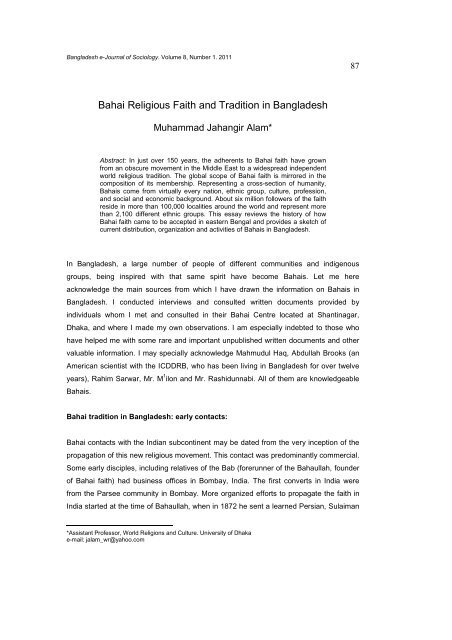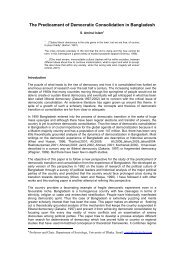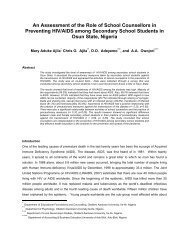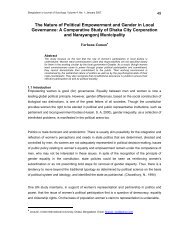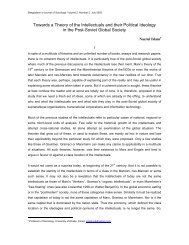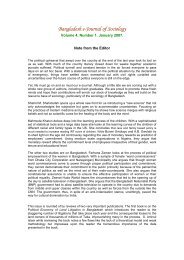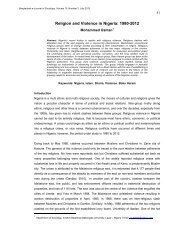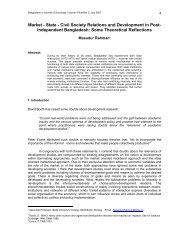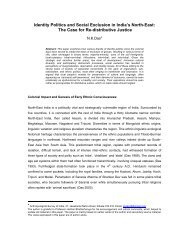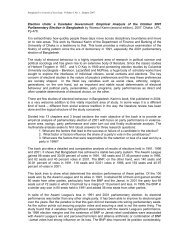Bahai Religion in Bangladesh - Bangladeshsociology.org
Bahai Religion in Bangladesh - Bangladeshsociology.org
Bahai Religion in Bangladesh - Bangladeshsociology.org
Create successful ePaper yourself
Turn your PDF publications into a flip-book with our unique Google optimized e-Paper software.
<strong>Bangladesh</strong> e-Journal of Sociology. Volume 8, Number 1. 201187<strong>Bahai</strong> Religious Faith and Tradition <strong>in</strong> <strong>Bangladesh</strong>Muhammad Jahangir Alam*Abstract: In just over 150 years, the adherents to <strong>Bahai</strong> faith have grownfrom an obscure movement <strong>in</strong> the Middle East to a widespread <strong>in</strong>dependentworld religious tradition. The global scope of <strong>Bahai</strong> faith is mirrored <strong>in</strong> thecomposition of its membership. Represent<strong>in</strong>g a cross-section of humanity,<strong>Bahai</strong>s come from virtually every nation, ethnic group, culture, profession,and social and economic background. About six million followers of the faithreside <strong>in</strong> more than 100,000 localities around the world and represent morethan 2,100 different ethnic groups. This essay reviews the history of how<strong>Bahai</strong> faith came to be accepted <strong>in</strong> eastern Bengal and provides a sketch ofcurrent distribution, <strong>org</strong>anization and activities of <strong>Bahai</strong>s <strong>in</strong> <strong>Bangladesh</strong>.In <strong>Bangladesh</strong>, a large number of people of different communities and <strong>in</strong>digenousgroups, be<strong>in</strong>g <strong>in</strong>spired with that same spirit have become <strong>Bahai</strong>s. Let me hereacknowledge the ma<strong>in</strong> sources from which I have drawn the <strong>in</strong>formation on <strong>Bahai</strong>s <strong>in</strong><strong>Bangladesh</strong>. I conducted <strong>in</strong>terviews and consulted written documents provided by<strong>in</strong>dividuals whom I met and consulted <strong>in</strong> their <strong>Bahai</strong> Centre located at Shant<strong>in</strong>agar,Dhaka, and where I made my own observations. I am especially <strong>in</strong>debted to those whohave helped me with some rare and important unpublished written documents and othervaluable <strong>in</strong>formation. I may specially acknowledge Mahmudul Haq, Abdullah Brooks (anAmerican scientist with the ICDDRB, who has been liv<strong>in</strong>g <strong>in</strong> <strong>Bangladesh</strong> for over twelveyears), Rahim Sarwar, Mr. M 1 ilon and Mr. Rashidunnabi. All of them are knowledgeable<strong>Bahai</strong>s.<strong>Bahai</strong> tradition <strong>in</strong> <strong>Bangladesh</strong>: early contacts:<strong>Bahai</strong> contacts with the Indian subcont<strong>in</strong>ent may be dated from the very <strong>in</strong>ception of thepropagation of this new religious movement. This contact was predom<strong>in</strong>antly commercial.Some early disciples, <strong>in</strong>clud<strong>in</strong>g relatives of the Bab (forerunner of the Bahaullah, founderof <strong>Bahai</strong> faith) had bus<strong>in</strong>ess offices <strong>in</strong> Bombay, India. The first converts <strong>in</strong> India werefrom the Parsee community <strong>in</strong> Bombay. More <strong>org</strong>anized efforts to propagate the faith <strong>in</strong>India started at the time of Bahaullah, when <strong>in</strong> 1872 he sent a learned Persian, Sulaiman*Assistant Professor, World <strong>Religion</strong>s and Culture. University of Dhakae-mail: jalam_wr@yahoo.com
<strong>Bangladesh</strong> e-Journal of Sociology. Volume 8, Number 1. 201188Khan Tunukabani, better known as Jamal Effendi, to India. This Jamal Effendi was an<strong>in</strong>fluential figure <strong>in</strong> the cultural life of the Indian subcont<strong>in</strong>ent. He visited almost all themajor cities of India and arrived <strong>in</strong> Kolkata <strong>in</strong> 1878. In the course of his travels <strong>in</strong> India hemet a young man, Siyyid Mustafa Roumi, <strong>in</strong> Madras. Impressed by the great spiritualpersonality of Effendi, Roumi accepted the new religious faith and accompanied him onhis journey to Bengal and Burma. Jamal Effendi was an <strong>in</strong>fluential preacher and had alarge follow<strong>in</strong>g of learned <strong>Bahai</strong> missionaries. They sought out great Muslim religious andother notables and discussed with them the advent of a new message from God. By theirreligious fervor, missionary zeal, exemplary character and humanitarian activities, theycould greatly <strong>in</strong>fluence the m<strong>in</strong>ds of the masses and attract them to <strong>Bahai</strong> faith. On theirway to Burma Jamal Effendi and Roumi stopped <strong>in</strong> Dhaka and Chittagong for a few daysand met notables of both cities. There is no doubt that under the guidance of EffendiMustafa Roumi played a vital role <strong>in</strong> <strong>in</strong>troduction of <strong>Bahai</strong> faith <strong>in</strong> <strong>Bangladesh</strong>.In the late eighteen-n<strong>in</strong>eties and early thirties <strong>Bahai</strong>s from the West had a large share <strong>in</strong>the spread of <strong>Bahai</strong> Faith among the great scholars and leaders. These Persian andWestern <strong>Bahai</strong>s had detailed discussions with Indian Intelligentsia that <strong>in</strong>cluded poet SirMohammad Iqbal, Sarojiono Naidu, Annie Besant, Rab<strong>in</strong>dranath Tagore and rulers of theIndian native states and their prime m<strong>in</strong>isters. Miss Martha Root, an American <strong>Bahai</strong>,who met Tagore on Feb. 13 & 14, 1938, remarks <strong>in</strong> her published memories he talkedabout his deep love and appreciation of Abdul Baha. There was an excellent collection of<strong>Bahai</strong> books <strong>in</strong> the library of Sant<strong>in</strong>iketan. Tagore expressed hope that there would be a<strong>Bahai</strong> chair at Sant<strong>in</strong>iketan. Those <strong>Bahai</strong>s created a good impression on their listenerswith their vast knowledge, modesty and tolerance of and respect for the views of others.First conversion to the new religion among the masses by Jamal Effendi’s and MustafaRoumi’s efforts occurred <strong>in</strong> Burma. Missionary zeal and ideal life of Jamal Effendi’scompanion Mustafa Roumi ga<strong>in</strong>ed a large number of converts particularly from thevillages. He served the cause of <strong>Bahai</strong> Faith <strong>in</strong> many ways and due to his good efforts <strong>in</strong>Barma drew the attention of a sizeable Bengali community there. One Sultan Gazi isconsidered to be the first person to accept the new religion from among the Bengalies. Bythe mid-1930s there was a small <strong>Bahai</strong> group <strong>in</strong> Chittagong. Small <strong>Bahai</strong> group belong<strong>in</strong>gto Satkania, Panchlaish and Putia of Chittagong were brought <strong>in</strong>to the faith by MustafaRoumi, Sultan Gazi and some other Burmese <strong>Bahai</strong>s. At the time of the partition of India<strong>in</strong> 1947 there were about n<strong>in</strong>e <strong>Bahai</strong>s <strong>in</strong> what became East Pakistan, all of them liv<strong>in</strong>g <strong>in</strong>Chittagong.
<strong>Bangladesh</strong> e-Journal of Sociology. Volume 8, Number 1. 201189In December 1948, Amjad Ali of Bihar, India settled downed <strong>in</strong> Dhaka with the aim ofdevelop<strong>in</strong>g the <strong>Bahai</strong> community <strong>in</strong> East Pakistan. He was followed byhis relatives andsome other <strong>Bahai</strong>s from West Bengal. Tak<strong>in</strong>g advantage of the peaceful atmosphere hewas able to establish a local govern<strong>in</strong>g body (local spiritual assembly) <strong>in</strong> Dhaka <strong>in</strong> 1952.It was the first local council to be elected <strong>in</strong> the eastern part of Pakistan. Later on withgradual <strong>in</strong>crease <strong>in</strong> the number of <strong>Bahai</strong>s another local assembly was elected <strong>in</strong>Chittagong <strong>in</strong> 1955 and a third one <strong>in</strong> Mymens<strong>in</strong>gha <strong>in</strong> 1961.Hundreds of <strong>Bahai</strong> preachers subsequently came to then East Pakistan <strong>in</strong> different timesfrom Iran, India, the USA, and other countries to help locally settled <strong>Bahai</strong>s <strong>in</strong> promot<strong>in</strong>gthe <strong>Bahai</strong> Faith. Some of those pioneers even settled down <strong>in</strong> <strong>Bangladesh</strong> for the sake oftheir religion (a person who settles <strong>in</strong> a foreign country for the sake of promot<strong>in</strong>g religionis called by the <strong>Bahai</strong>s a ‘pioneer’). In 1965 a great <strong>in</strong>itiative was taken to spread themessage of Baha Faith among the rural people. By 1971 there were about ten localassemblies <strong>in</strong> the prov<strong>in</strong>ce. To make the efforts more dynamic a <strong>Bahai</strong> centre wasestablished at Shanti Nagar <strong>in</strong> Dhaka.With emergence of <strong>in</strong>dependent <strong>Bangladesh</strong>, <strong>Bahai</strong>s also formed their own NationalSpiritual Assembly, which was elected <strong>in</strong> April 1972. This assembly and thirteen localassemblies were <strong>in</strong>corporated on June 2, 1972. Soon after the <strong>in</strong>dependence of<strong>Bangladesh</strong>, a delegation of <strong>Bahai</strong> representatives which <strong>in</strong>cluded a <strong>Bahai</strong> dignitaryfromIndia (Shir<strong>in</strong> Boman, Counselor) met the then Prime M<strong>in</strong>ister Sheikh Mujibur Rahman.The Prime M<strong>in</strong>ister assured the delegation that all religious m<strong>in</strong>orities were free topractice their religions <strong>in</strong> the <strong>in</strong>dependent, sovereign and secular <strong>Bangladesh</strong>. <strong>Bahai</strong>shave cont<strong>in</strong>ued this practice of meet<strong>in</strong>g with President, Prime M<strong>in</strong>ister, M<strong>in</strong>isters, PoliceChiefs, Justices and other relevant authorities .At the end of the first decade of<strong>in</strong>dependence there were <strong>Bahai</strong>s <strong>in</strong> 465 localities and 83 local assemblies. <strong>Bahai</strong> religionwas also taken to m<strong>in</strong>ority ethnic groups particularly <strong>in</strong> Chittagong and Rajshahi.Ethnic and Religious Background:<strong>Bahai</strong> Faith came with the Iranian Indian and Western <strong>Bahai</strong>s. The missionary works ofpioneers and preachers and the acceptance of <strong>Bahai</strong> faith by the Muslims, H<strong>in</strong>dus, anddifferent ethnic groups—who were attracted by its religious simplicity and social equalityand justice—resulted <strong>in</strong> the growth of the <strong>Bahai</strong> population and development of the <strong>Bahai</strong>Society of <strong>Bangladesh</strong>. I talked to some learned and lay converted <strong>Bahai</strong>s <strong>in</strong> theirCentre<strong>in</strong> Shanti Nagar, Dhaka and asked them why and how you have been attracted to
<strong>Bangladesh</strong> e-Journal of Sociology. Volume 8, Number 1. 201190a newfaith? All of them gave a more or less uniform answer: “<strong>Bahai</strong> vision of unity.” Letme share with you a view of a learned <strong>Bahai</strong> on this po<strong>in</strong>t.Dur<strong>in</strong>g the late seventies, I was serv<strong>in</strong>g <strong>in</strong> a Bank <strong>in</strong> Karachi, Pakistan. I came of aMuslimfamily but had lost my faith due to prejudices among Muslims. One day I found abookabout the <strong>Bahai</strong> faith entitled Bahaullah and New Eraand I immediately picked it up. Iread the book and was immediately attractedto the <strong>Bahai</strong> vision of Unity. When I learnedabout the <strong>Bahai</strong> concept of the unityof mank<strong>in</strong>d, I was much exited. I was <strong>in</strong>spired by the<strong>Bahai</strong> teach<strong>in</strong>gs, because they were free of prejudice.In 1989, after becom<strong>in</strong>g a <strong>Bahai</strong>, he migrated (as a pioneer) to <strong>Bangladesh</strong>, to help with<strong>Bahai</strong> projects <strong>in</strong> and outside Dhaka and topromote development among <strong>Bahai</strong>community <strong>in</strong> <strong>Bangladesh</strong>. F<strong>in</strong>ally he settled downed <strong>in</strong> Dhaka.<strong>Bahai</strong> people of <strong>Bangladesh</strong> come from different religious communities and ethnicgroups. The immigrant <strong>Bahai</strong>s belong ma<strong>in</strong>ly to the stock of the Persians, Indian andWestern countries. Till now no accurate statistical surveys, sociological studies orpopulation projection have been made to determ<strong>in</strong>e the number of followers. But aconservative estimate by the early 1990s says that there are around 60,000<strong>Bahai</strong>s <strong>in</strong><strong>Bangladesh</strong>. <strong>Bangladesh</strong>i <strong>Bahai</strong>s are serv<strong>in</strong>g <strong>in</strong> various important elected and appo<strong>in</strong>tedpositions of the country. <strong>Bahai</strong>s are th<strong>in</strong>ly spread allover the country. Socially it is difficultto categorize <strong>Bangladesh</strong>i <strong>Bahai</strong>s, but the majority of them lives <strong>in</strong> villages and generallybelong to the lower middleclass. <strong>Bahai</strong>s of both urban and village areas are engagedapart from agriculture, <strong>in</strong> small bus<strong>in</strong>ess, government and private employment andtechnical jobs. <strong>Bangladesh</strong>i <strong>Bahai</strong>s have achieved about 95 percent literacy rate <strong>in</strong>contrast to a national literacy rate of less than 50%.<strong>Bahai</strong> literature <strong>in</strong> Bengali:The first <strong>Bahai</strong> book to be translated <strong>in</strong>to Bengali was Bahaullah and the NewEra, writtenby Dr. J.E Esslemont, an English <strong>Bahai</strong>. It was translated by Amirul Islam, a dedicatedBengali <strong>Bahai</strong>. This translation was published <strong>in</strong> 1936 <strong>in</strong>Kolkata. This book is consideredto be the authoritative <strong>in</strong>troduction to the <strong>Bahai</strong> faith. This book is very important becauseit is followed by translations of <strong>Bahai</strong> holy scriptures like the Hidden Words and the Kitabi-Iqan(Bookof Certitude). These two books were translated by Safdar Ahmed, a <strong>Bahai</strong>from Chittagong. Presently there are about 60 titles <strong>in</strong> Bengali language, rang<strong>in</strong>g <strong>in</strong>subjects from the writ<strong>in</strong>gs of the central figures of the religion to its history, adm<strong>in</strong>istrativesystem, <strong>in</strong>troduction to religion and textbooks for <strong>Bahai</strong> students. It should be mentionedthat all of these books have been translated from English versions. There are also many<strong>Bahai</strong> booklets and pamphlets <strong>in</strong> Bengali. These too are translations of English versions.Some periodicals are also published, though not very regularly. One such periodical
<strong>Bangladesh</strong> e-Journal of Sociology. Volume 8, Number 1. 201191isNobo Dibosh, which is be<strong>in</strong>g published s<strong>in</strong>ce July 1987. The most sacred and importantscripture of <strong>Bahai</strong>s is the Kitab-i-Aqdas (Most Holy Book). Revealed dur<strong>in</strong>g the dark daysof Bahaullah’s imprisonment <strong>in</strong> Acre, it is the chief repository of the laws and <strong>in</strong>stitutionswhich Bahaullah designed for the world order he conceived. It was written <strong>in</strong> Arabic andis characterized by a wide range of styles. The Most Holy Book was translated <strong>in</strong>toBengali from its authorized English version for publication<strong>in</strong> 1998. <strong>Bahai</strong>s keep theirlibrary opened to all. Therefore anyone can visit their library and collect pamphlets andperiodicals.Social Work:Let me start this section with a quotation, “Let your vision be world embrac<strong>in</strong>g,rather thanconf<strong>in</strong>ed to your own self.” Therefore around the globe, <strong>Bahai</strong>s are united by a commonoutlook that holds to high moral standards, a modern worldview, and a commitment toserv<strong>in</strong>g the wider community. As a result Bhais consider spread<strong>in</strong>g the message ofreligious tolerance, cooperation, unity, consultation and village-based decision-mak<strong>in</strong>g aslay<strong>in</strong>g the foundation of a new society which will solve social ills more comprehensivelyand more effectively. <strong>Bahai</strong>s believe that the purpose of earthly life is to acquire spiritualqualities, such as love, faith, and self-service. They seek to fulfill this purpose throughavariety personal, family, and community actions. They undertake public projects asimportant means for the tra<strong>in</strong><strong>in</strong>g of the soul. In the same way with grow<strong>in</strong>g numbers plus<strong>in</strong>creas<strong>in</strong>g resources and experience, <strong>Bahai</strong>s <strong>in</strong> <strong>Bangladesh</strong> are tak<strong>in</strong>g up more andmore projects of social work like medical camps, vocational tra<strong>in</strong><strong>in</strong>g and the like. In 1983the National <strong>Bahai</strong> Development Institute was established to tra<strong>in</strong> teachers for villagetutorial schools, as well as for runn<strong>in</strong>g cl<strong>in</strong>ics for poor women and children. S<strong>in</strong>ce1994annual courses are held to tra<strong>in</strong> rural health workers. Conscious efforts are made to<strong>in</strong>volve women <strong>in</strong> all community affairs. Women are serv<strong>in</strong>g <strong>in</strong> important <strong>Bahai</strong>adm<strong>in</strong>istrative posts. They have served as secretary of National Spiritual Assembly <strong>in</strong><strong>Bangladesh</strong>.Propagation of the faith:Giv<strong>in</strong>g the message of <strong>Bahai</strong> religion to others is called ‘teach<strong>in</strong>g the Cause’ bythe<strong>Bahai</strong>s. In the absence of a clergy this is an obligation of every <strong>in</strong>dividual <strong>Bahai</strong>. In<strong>Bangladesh</strong> the method usually adopted is that <strong>Bahai</strong>s go to a village where there isalready a <strong>Bahai</strong> or a sympathizer who helps <strong>in</strong> meet<strong>in</strong>g people <strong>in</strong>terested to hear aboutthe <strong>Bahai</strong> religion. They keep many pamphlets, booklets, newsletters; periodicals etc.


